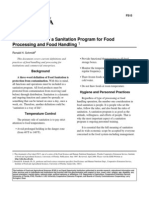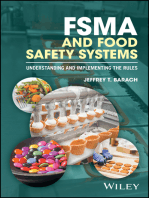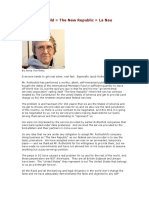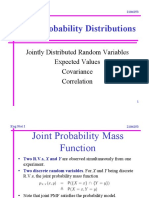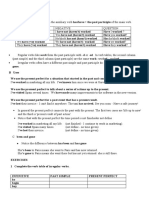Prerequisite Programs (PRPS) Provide The Hygienic Foundations For Any Food Operation. The Terms
Prerequisite Programs (PRPS) Provide The Hygienic Foundations For Any Food Operation. The Terms
Uploaded by
Mawee LastrellaCopyright:
Available Formats
Prerequisite Programs (PRPS) Provide The Hygienic Foundations For Any Food Operation. The Terms
Prerequisite Programs (PRPS) Provide The Hygienic Foundations For Any Food Operation. The Terms
Uploaded by
Mawee LastrellaOriginal Description:
Original Title
Copyright
Available Formats
Share this document
Did you find this document useful?
Is this content inappropriate?
Copyright:
Available Formats
Prerequisite Programs (PRPS) Provide The Hygienic Foundations For Any Food Operation. The Terms
Prerequisite Programs (PRPS) Provide The Hygienic Foundations For Any Food Operation. The Terms
Uploaded by
Mawee LastrellaCopyright:
Available Formats
TH2012
Introduction to Prerequisite Programs
Prerequisite programs (PRPs) provide the hygienic foundations for any food operation. The terms
‘prerequisite program’, ‘good manufacturing practice (GMP)’, ‘good hygiene practice’, and ‘sanitary operating
practices’ are used interchangeably in different contexts but have the same general meaning. Several groups
have suggested definitions for the term ‘prerequisites’ and the most commonly used are:
o Practices and conditions needed before and during the implementation of HACCP and which are
essential to food safety (World Health Organization [WHO], 1999).
o Universal steps or procedures that control the operating conditions within a food establishment,
allowing for environmental conditions that are favorable for the production of safe food (Canadian
Food Inspection Agency [CFIA], 1998).
o Procedures, including GMP, which address operational conditions, providing the foundation for the
HACCP System (The National Advisory Committee for Microbiological Criteria for Foods [NACMCF],
1997).
Several groups have published helpful materials on PRPs. However, the internationally accepted requirements
for prerequisites are defined in the Codex General Principles of Food Hygiene (Codex, 2009a). The PRPs listed
below are split down into groupings:
Primary Production Establishment: personal hygiene
Establishment: design and facilities Transportation
Control of operation Product information and consumer
Establishment: maintenance and awareness
sanitation Training
These groupings form the essential areas where PRP elements must be developed, implemented, and
maintained to provide environmental conditions that are favorable to the production of safe food and thus,
the foundations needed for effective HACCP systems.
International Requirements of Codex
Primary Production
At this stage of the food chain, the intention is that food produced is safe and suitable for its intended use and
primary production PRPs are, therefore, based on appropriate hygienic practices; control of contaminants,
pests and diseases; and use of production areas where there are no environmental threats to the production
of food (Wallace, 2011). Below are the PRP elements for primary production.
• Environmental hygiene requires the consideration of potential contamination sources from the
environment and prevention of the use of areas that could cause the presence of unacceptable levels
of potentially harmful substances in the food produced.
• Hygienic production of food sources relates to the need to identify likely sources of contamination
and implement controls to minimize the risk of contamination, including prevention of contamination
from air, soil, water, and other agricultural agents; controlling animal health to minimize threats to
human health at consumption; protecting food from fecal or other contamination; and managing
wastes and harmful substances appropriately.
• Handling, storage, and transport describes the protection, segregation, and disposal requirements
needed to protect food, preventing spoilage and deterioration where possible (e.g., through control
of temperature and humidity).
• Cleaning, maintenance, and personal hygiene at primary production refers to the necessity for
appropriate procedures and facilities for the maintenance of these essential practices.
02 Handout 1 *Property of STI
student.feedback@sti.edu Page 1 of 6
TH2012
Establishment: Design and Facilities
PRP Elements for Establishment: Design and Facilities
• The location of food premises is important and care should be taken to identify and consider the risks
of potential sources of contamination in the surrounding environmentally polluted areas. Areas of
heavy industry that could pose contamination risks, areas prone to pest infestation, areas subject to
flooding, or where waste cannot be removed effectively should be avoided when planning food
production facilities. Suitable controls to prevent contamination should be developed and
implemented.
• The design and layout of the premises and rooms should permit good hygiene and protect products
from cross-contamination during operation. Internal structures and equipment should be built of
materials able to be easily cleaned/disinfected and maintained. Surfaces should be smooth and non-
pervious, and able to withstand the normal conditions of the operation.
Other surfaces within the food processing area, like walls, floors, partitions, ceilings and overhead
fixtures, windows, and doors should similarly be designed to minimize the building up of dirt,
condensation, etc., and the shredding of particles or contaminants that might gain access to food
products. A similar standard should be applied to the design, construction, and siting of
temporary/mobile premises and food vending machines.
• Equipment that will come into contact with food should also be designed and constructed to facilitate
cleaning and disinfection, including disassembly where necessary, and be made of materials that will
have no toxic effects under the intended use.
Containers for by-products, waste, inedible, and dangerous substances must be constructed to protect
food from contamination and should be specifically identifiable, including appropriate security
considerations to prevent accidental discharge or malicious contamination.
• Facilities should be provided to include adequate potable water supplies, suitable drainage and waste
disposal, appropriate cleaning facilities, storage areas, lighting, ventilation, and temperature control.
Suitable facilities should also be provided to promote personal hygiene for the workforce, including
adequate changing areas, lavatories, and handwashing and drying facilities.
Control of Operation
The rationale of operational control listed in Codex (2009a) is ‘to reduce the risk of unsafe food by taking
preventive measures to assure the safety and suitability of food at an appropriate stage in the operation by
controlling food hazards’. The following are the PRP elements in the control of operation:
• Control of food hazards requires the use of a system such as HACCP throughout the food chain to
identify any steps in food operations that are critical to food safety; implement effective control
procedures at those steps; monitor control procedures to ensure its continuing effectiveness; and
review control procedures periodically, and whenever the operations change.
Key Aspects of Hygiene Control Systems (Codex, 2009a)
o Time and temperature control to prevent common causes of foodborne illnesses.
o Use of specific process steps that can contribute to food hygiene (e.g., chilling or modified
atmosphere packaging).
o Microbiological and other specifications based on thorough scientific principles.
o Management techniques to control microbiological cross-contamination risks (e.g.,
segregation of processes/parts of processes and restricted access procedures).
o Physical and chemical contamination prevention, including the use of suitable detection
or screening devices when necessary.
02 Handout 1 *Property of STI
student.feedback@sti.edu Page 2 of 6
TH2012
Effective allergen management requires an integrated approach throughout the product stream/flow.
Each stage of the product lifecycle should be considered.
Stages of Product Lifecycle
During product design – is the allergen already in use in the plant? Is the allergen already
in use on the same process line?
Hidden supplier control programs – what allergens are used in the supplier’s plant? Has
the supplier program been verified during an on-site visit?
During manufacture – to prevent cross-contamination, a basis for sequencing schedules
and rework procedures must be set in place.
This basis refers to a formalized allergen control program that will be developed by
conducting an allergen risk evaluation. Elements of this include:
o Listing all allergenic materials that are on-site (raw material specifications).
o Listing all products manufactured together with the allergenic raw materials that go
into them (matrix of products and ingredients).
o Develop a diagram or use the HACCP documents (allergen process flow).
Transportation and Labelling – this includes the requirements to protect food from cross-
contamination during transit and the need to ensure that all allergens are clearly and
accurately labeled on the package.
• Incoming material requirements and systems to ensure the safety of materials and ingredients at the
start of processing is necessary to protect operation and its products. This PRP element covers the
need for appropriate specifications and acceptance procedures to prevent the acceptance of
hazardous raw materials and ingredients that would not be controlled by a process, including the use
of appropriate inspection and sorting procedure along with effective stock rotation.
• Suitable packaging design to provide the necessary protection to a product during its shelf life is also
highlighted by Codex (2009a). This embraces the need to ensure that the chosen packaging system is
safe and will not pose a threat to a food product, plus the requirement to ensure hygienic conditions
of reusable packaging (e.g., refillable glass bottles).
• Use of potable water is also important for hygienic control especially where water is a food ingredient
and for all food handling and processing operations, except specific food processes where non-potable
water would not cause a contamination hazard to a food.
The need to treat and monitor any water being recirculated for reuse is also described, as is the
requirement to make ice only from potable water and to ensure the safety and suitability of steam for
direct food contact. It is sometimes necessary to install an in-plant water treatment system to ensure
a supply of potable water.
• Appropriate management and supervision, reflecting the size of the operation and nature of its
activities and processes, is also highlighted, with the need to ensure personnel has enough knowledge
of food hygiene principles to be able to form a judgment on likely risks and take necessary actions.
• Documentation and records should also be kept adequate and maintained for a period exceeding the
shelf life of products/food items.
• Recall procedures should also be developed and tested so that the products can be effectively
withdrawn and recalled if a food safety problem is highlighted.
02 Handout 1 *Property of STI
student.feedback@sti.edu Page 3 of 6
TH2012
Establishment: Maintenance and Sanitation
This stage is a broad-ranging prerequisite grouping that includes the elements of cleaning and
disinfection/sanitation, pest management and waste management, plus the need to monitor the effectiveness
of these elements in all cases. Below are the PRP elements in establishment maintenance and sanitation.
• Maintenance and cleaning are both important to keep the processing environment, facilities, and
equipment in a good taste of repair, where it can both function as intended and prevent cross-
contamination with food residues and microorganisms that might otherwise build up.
Maintenance and cleaning are performed normally involving the following:
o Operating facilities with preventive maintenance programs as well as attending to breakdowns
and faults without delay
o Removing gross debris immediately
o Applying detergent solution/s
o Rinsing with potable water
o Disinfection/sanitation as often as necessary
Dry cleaning or other appropriate methods may be used as appropriate to the specific situation, and
all chemicals used should be handled and stored carefully to prevent contamination of food products.
• Cleaning programs should be developed to encompass all equipment and facilities as well as general
environmental cleaning, and this may require specialist/expert advice. Cleaning methods need to be
developed that are suitable for an item to be cleaned and should describe both the method and
frequency of cleaning specific areas and items of equipment and the responsibility for the tasks.
Records of cleaning and monitoring should also be kept.
• Pest control systems are important to prevent the access of pests that might cause contamination to
a product and good hygienic practices are necessary to prevent the creation of an environment
conducive to pest infestation.
Buildings need to be made pest-proof and regularly inspected for potential ingress points. This
will include sealing of holes, drains, etc., to prevent pest access and suitable screening (e.g.
wire mesh on any opening windows, vents, and doors).
Interior and exterior areas need to be kept clean and tidy to minimize potential food and
harborage sources. All potential food sources (including reuse) should be kept in suitable
containers off the ground and away from walls.
Suitable interior traps and monitoring devices should also be considered, and any pest
infestations need to be dealt with promptly, without adversely affecting food safety.
• Waste management should ensure that waste materials can be removed and stored safely so that
these do not provide a cross-contamination risk or become a food or harborage source for pests.
Waste must not be allowed to accumulate in food handling and storage areas and the adjoining
environment and waste areas must be kept clean at all times.
There is a need to monitor the effectiveness of all maintenance and sanitation systems, and these should be
verified and reviewed periodically, with changes made to reflect operational changes. Audit, inspection, and
other tools such as microbiological environmental sampling can be used to facilitate the verification of these
prerequisite elements.
Establishment: Personal Hygiene
The objectives for personal hygiene stated in Codex (2009a) are maintaining an appropriate degree of personal
cleanliness, and behaving and operating appropriately. The following are the PRP elements for establishment
personal hygiene:
02 Handout 1 *Property of STI
student.feedback@sti.edu Page 4 of 6
TH2012
• Establishment of health status is important where individuals may be carrying a disease that can be
transmitted through food. Anyone known or suspected to be carrying such disease should not be
permitted in food-handling areas. Food-handling personnel should be trained to report illness or
symptoms to the management, and medical examinations should be done if necessary.
• Consideration of illness and injuries that may require affected staff members to be excluded or wear
appropriate dressings should be done. The following conditions should be reported so that any need
for medical examination or exclusion can also be considered as listed by Codex (2009a):
× Jaundice × Fever or sore throat with fever
× Diarrhea × Visibly infected skin lesions (e.g. boils and cuts)
× Vomiting × Discharges from the ear, eye, or nose
• Personal cleanliness including effective hand-washing and the wearing of adequate protective
clothing and footwear is also highlighted.
• Similarly, the prevention of inappropriate personal behavior such as smoking, eating, or chewing in
food-handling areas should be enforced, and personal accessories should be prohibited in food-
handling areas. Visitors to processing and product-handling areas should be adequately supervised
and required to follow the same standards of personal hygiene as employees.
• Personal protective equipment (PPE), which include visors, face masks, gloves, safety spectacles, ear
defenders, overalls and footwear with non-slip soles and metal toe caps, and head protection like hard
hats and caps, are provided to protect the operator from the food processing environment and specific
safety hazards as appropriate.
• Protective clothing like hairnets, coats, thermal wear/suits, aprons, wrist and forearm sleeves, and
trousers are provided by the food manufacturer primarily to protect the food from microorganisms.
Transportation
To ensure food safety during transportation, transport facilities need to be designed and managed to protect
food products from potential contamination and damage, and to prevent the growth of pathogens. These are
the PRP elements for transportation:
• General requirements include the need for protection of food during transit.
• Design requirements include the design of containers and conveyances to facilitate protection during
transit.
• Use and maintenance requirements for vehicles and containers include appropriate standards of
cleanliness and disinfection between loads as appropriate. Containers should be both marked for and
used for ‘food use only’, where appropriate and temperature control devices are used when
necessary.
Product Information and Consumer Awareness
Product information is important both for following links in the food chain and for the final food handler and
consumer. Insufficient information or inadequate knowledge can lead to products being mishandled, and
ultimately, to both foodborne illness and product wastage. The following are the PRP elements for product
information and consumer awareness:
• Lot identification information is easily identifiable on products so that the lot or batch can be
identified for recall purposes, a product can be handled correctly, and that stock rotation is facilitated.
This will include permanent marking to identify the producer and the lot.
• Product information and labeling should be clear and sufficient such that it facilitates the correct
handling, storage, preparation, and use of food by the next person in the food chain.
02 Handout 1 *Property of STI
student.feedback@sti.edu Page 5 of 6
TH2012
• Consumer education is important in following handling instructions and the link between
time/temperature and foodborne illness.
Training
This is the final PRP element described by Codex (2009a), which is highlighted as “fundamentally important to
any food hygiene system”, since inadequate training, instruction, and/or supervision can pose threats to food
safety.
• Food hygiene training is essential to promote awareness in food handling personnel of their roles and
responsibilities for food control.
• Training programs should be developed and implemented by companies. Training is likely to include
details on the type(s) of food handled and produced, and their ability to support the growth of food
pathogens, plus control and monitoring procedures, such as the following:
Process activities Labeling and shelf life
Packaging systems Specific requirements
Handling and storage
requirements
(e.g., monitoring CCPs under HACCP plans)
• Instruction and supervision of personnel and ongoing monitoring of food hygiene behavior should be
adequate. Managers and supervisors should have levels of food hygiene knowledge that will allow
them to judge potential food safety risks and take appropriate action.
• Refresher training is also needed for current training to be evaluated, reviewed, and updated as
necessary.
Prerequisite programs are the basic standards for a food facility, in which a safely designed product can be
manufactured. These form the hygiene foundations on which the HACCP system is built to control food safety
operations every day.
References:
Motarjemi, Y. (Ed.), & Lelieveld, H. (Ed.). (2014). Food safety management: A practical guide for the food industry. Elsevier Inc.
Wallace, C. A. (2011). Food safety for the 21st century: Managing HACCP and food safety throughout the global supply chain. John
Wiley & Sons, Inc.
02 Handout 1 *Property of STI
student.feedback@sti.edu Page 6 of 6
You might also like
- Food Safety ChampionsDocument7 pagesFood Safety Championsthanveer789No ratings yet
- Handbook of Microbiological Criteria for FoodsFrom EverandHandbook of Microbiological Criteria for FoodsNo ratings yet
- RSPH Level 4 Award in Haccp Management For Food ManufacturingDocument19 pagesRSPH Level 4 Award in Haccp Management For Food ManufacturingHema HemaNo ratings yet
- Tiffin ServiceDocument17 pagesTiffin Servicehardik patel0% (1)
- Basic Elements of A Sanitation Program For Food ProcessingDocument5 pagesBasic Elements of A Sanitation Program For Food ProcessingJohn Henry Wells100% (2)
- EMP in The Age of FSMADocument76 pagesEMP in The Age of FSMAmusfirahNo ratings yet
- HACCP Infomation All 1102Document98 pagesHACCP Infomation All 1102nome2kNo ratings yet
- Struthers, J. Keith-Clinical Microbiology-CRC Press (2018)Document299 pagesStruthers, J. Keith-Clinical Microbiology-CRC Press (2018)Rosantia Sarassari100% (8)
- Class 5 Casestudy LucentDocument3 pagesClass 5 Casestudy LucentDoreen WangNo ratings yet
- Food Safety PDFDocument11 pagesFood Safety PDFMaria AnnieskaNo ratings yet
- FAO Guide to Ranking Food Safety Risks at the National LevelFrom EverandFAO Guide to Ranking Food Safety Risks at the National LevelNo ratings yet
- FSMA and Food Safety Systems: Understanding and Implementing the RulesFrom EverandFSMA and Food Safety Systems: Understanding and Implementing the RulesNo ratings yet
- Food Control System Assessment Tool: Dimension B – Control FunctionsFrom EverandFood Control System Assessment Tool: Dimension B – Control FunctionsNo ratings yet
- Food Control System Assessment Tool: Introduction and GlossaryFrom EverandFood Control System Assessment Tool: Introduction and GlossaryNo ratings yet
- Good Catering Practice Audits (GCP) : Food ServicesDocument2 pagesGood Catering Practice Audits (GCP) : Food ServicesgozdeNo ratings yet
- Specific Aspects of Food Safety AuditingDocument62 pagesSpecific Aspects of Food Safety AuditingfaisalNo ratings yet
- Management Review TrainingDocument1 pageManagement Review TrainingFloreidNo ratings yet
- Food Traceability Withdrawals and Recalls GuidanceDocument56 pagesFood Traceability Withdrawals and Recalls GuidanceQualidade SegurançaNo ratings yet
- Alsop 17 A Laundry and Linen UseDocument2 pagesAlsop 17 A Laundry and Linen UseChandan Srivastava100% (1)
- Principle 6: Verification: How Is This Stage Achieved?Document4 pagesPrinciple 6: Verification: How Is This Stage Achieved?Misarda BerishaNo ratings yet
- Food Safety Culture PlanDocument55 pagesFood Safety Culture Planadhe hildaNo ratings yet
- Food Safety and Quality Culture: Drives RealDocument6 pagesFood Safety and Quality Culture: Drives Realsercalsa100% (1)
- Campden Bri Food Drink Publications CatalogDocument20 pagesCampden Bri Food Drink Publications CatalogDavid0% (1)
- Zoning in Processing Facilities 375003 7Document2 pagesZoning in Processing Facilities 375003 7TinnysumardiNo ratings yet
- Food Safety Issue 8 Checklist EnglishDocument20 pagesFood Safety Issue 8 Checklist EnglishKSXNo ratings yet
- Guide To Implementing Iso 22000Document34 pagesGuide To Implementing Iso 22000getaneh abebeNo ratings yet
- Food Safety Risk Assement Guide PDFDocument24 pagesFood Safety Risk Assement Guide PDFruhul bayanNo ratings yet
- Basics of HACCP and Prerequisite ProgramsDocument22 pagesBasics of HACCP and Prerequisite ProgramsAnonymous A1G77Sw59100% (1)
- Book BFTestFlip TestDocument2 pagesBook BFTestFlip TestTaylorShannon100% (1)
- Determining Control MeasuresDocument17 pagesDetermining Control MeasuresGaganpreet KaurNo ratings yet
- CXG - 069e Guideline For The Validation of Food Safety Control MeasuresDocument10 pagesCXG - 069e Guideline For The Validation of Food Safety Control MeasuresYêu Thời Trang SophieParis100% (1)
- FSSC 22000 Quick Start GuideDocument28 pagesFSSC 22000 Quick Start GuideMartha Limo FigueroaNo ratings yet
- Food Safety and Hygiene LayoutDocument9 pagesFood Safety and Hygiene LayoutJann Kerky100% (1)
- Difference Between HACCP, VACCP & TACCPDocument9 pagesDifference Between HACCP, VACCP & TACCPpetrus jacob100% (1)
- How To Determine Microbiological Shelf-Life of Products: Gail - Betts@campdenbri - Co.ukDocument9 pagesHow To Determine Microbiological Shelf-Life of Products: Gail - Betts@campdenbri - Co.ukdaianeelisNo ratings yet
- Food Safety Management ProceeduresDocument4 pagesFood Safety Management ProceeduresRulment Dardanei100% (1)
- How To Establish An FSSC 22000 ProgramDocument16 pagesHow To Establish An FSSC 22000 ProgramfaisalNo ratings yet
- Haccp Manual: Hawaii International Seafood, IncDocument70 pagesHaccp Manual: Hawaii International Seafood, IncCamelia Stremtan0% (1)
- Food Sci and Tech - 2019 - Hygienic Engineering DesignDocument3 pagesFood Sci and Tech - 2019 - Hygienic Engineering DesignGS LiNo ratings yet
- Conducting Root Cause Analysis.Document19 pagesConducting Root Cause Analysis.SARA JABARNo ratings yet
- Food Safety Management System BRCS GSDocument47 pagesFood Safety Management System BRCS GSwindy hartonoNo ratings yet
- Better HACCP ImplementationDocument43 pagesBetter HACCP ImplementationMuhammad Asadullah100% (1)
- Guidebook For The Preparation of HACCP PlansDocument74 pagesGuidebook For The Preparation of HACCP Planslatog13100% (1)
- Management: ProgramsDocument10 pagesManagement: ProgramsMike SajaNo ratings yet
- FSSC 22000 Audit Checklist Sample Report IAuditorDocument21 pagesFSSC 22000 Audit Checklist Sample Report IAuditorkarimNo ratings yet
- Iso 22000 2018 Sample8 PDFDocument9 pagesIso 22000 2018 Sample8 PDFGabriel DoméNo ratings yet
- Quality Food Safety Policy March 2019Document2 pagesQuality Food Safety Policy March 2019Cristina NicoletaNo ratings yet
- GFSI Food Safety Culture SummaryDocument5 pagesGFSI Food Safety Culture SummaryEileen Le RouxNo ratings yet
- Guidance For Allergen Management and TestingDocument13 pagesGuidance For Allergen Management and TestingVasil TsonkovNo ratings yet
- BRC Food Culture Guidelines Mar19Document3 pagesBRC Food Culture Guidelines Mar19senarathNo ratings yet
- Listeria Monocytogenes Guidance On: Environmental Monitoring and Corrective Actions in At-Risk FoodsDocument35 pagesListeria Monocytogenes Guidance On: Environmental Monitoring and Corrective Actions in At-Risk FoodsGaganpreet KaurNo ratings yet
- Food Safety CultureDocument9 pagesFood Safety CultureSimone BalianNo ratings yet
- Requirements For The FSSC 22000 V5 Upgrade ProcessDocument3 pagesRequirements For The FSSC 22000 V5 Upgrade Processfiqrans100% (2)
- Allergen ControlDocument20 pagesAllergen Controlmedtaher missaoui100% (1)
- Withdrawal ManualDocument47 pagesWithdrawal Manualatvenu16160No ratings yet
- Microbial Risk AssessmentDocument9 pagesMicrobial Risk AssessmentPamela Bórquez ReussNo ratings yet
- Sensory Evaluation of TunaDocument23 pagesSensory Evaluation of TunaRylNo ratings yet
- GMP Audit Check List-Sanitation & HygieneDocument1 pageGMP Audit Check List-Sanitation & HygieneDharmesh Patel100% (1)
- 12 HACCP ValidationDocument45 pages12 HACCP ValidationSartika Mutiarasani100% (1)
- Validation of Control Measures in A Food Chain Using The FSO ConceptDocument7 pagesValidation of Control Measures in A Food Chain Using The FSO Conceptcaraquena123No ratings yet
- Delegate Hand Book ISO 22000 Internal AuditDocument24 pagesDelegate Hand Book ISO 22000 Internal AuditKhaled KayaliNo ratings yet
- Bip 2078-2007Document236 pagesBip 2078-2007clive100% (1)
- 0 - ODI Installation & ConfigurationDocument18 pages0 - ODI Installation & ConfigurationparmitchoudhuryNo ratings yet
- Request For Relevant MaterialDocument1 pageRequest For Relevant Materialsandra kivedoNo ratings yet
- Kelompok 5 Quality CostDocument36 pagesKelompok 5 Quality CostMuhamad ArnaldoNo ratings yet
- Jacob Rothschild The New Republic La Neu RepubliqueDocument3 pagesJacob Rothschild The New Republic La Neu RepubliqueNeal Hill Compton100% (1)
- Kumaravel's ResumeDocument3 pagesKumaravel's ResumeKumarNo ratings yet
- 5 Joint Probability Distribution.7245.1583725420.9784Document30 pages5 Joint Probability Distribution.7245.1583725420.9784Pun AditepNo ratings yet
- Vim1 v14 SCHDocument10 pagesVim1 v14 SCHweiwei LiuNo ratings yet
- Value Chain Management Project Due Date: On The Final Exam DateDocument4 pagesValue Chain Management Project Due Date: On The Final Exam Dateminale destaNo ratings yet
- Garcia v. HRETDocument9 pagesGarcia v. HRETjeffprox69No ratings yet
- Pol Science David EastonDocument4 pagesPol Science David EastonKrish KalroNo ratings yet
- List of Melaka CompaniesDocument3 pagesList of Melaka CompaniesNasrul SalmanNo ratings yet
- The Present Perfect 1Document5 pagesThe Present Perfect 1CHAIMA DEYNo ratings yet
- Sentinel Chart RecorderDocument4 pagesSentinel Chart RecorderSandi AslanNo ratings yet
- Taj GVK Hotels & Resorts LTDDocument133 pagesTaj GVK Hotels & Resorts LTDoberoi singhNo ratings yet
- Functional Safety Report (V1.01)Document16 pagesFunctional Safety Report (V1.01)boyu wangNo ratings yet
- Đề Cương HK2 TA6 + KEY (21-22)Document6 pagesĐề Cương HK2 TA6 + KEY (21-22)imheleneduhhhNo ratings yet
- Rejinpaul App From Playstore: D. VirtualDocument7 pagesRejinpaul App From Playstore: D. VirtualNanga MadhuriNo ratings yet
- 8 - Chapter - INVESTMENT PROPERTYDocument49 pages8 - Chapter - INVESTMENT PROPERTYchingNo ratings yet
- 1221 Hot Gas and Extrusion Welding Jan 2016Document2 pages1221 Hot Gas and Extrusion Welding Jan 2016ibnu.asad984No ratings yet
- Hindustan Unilever Limited: Powerpoint Presentation of Company Law OnDocument34 pagesHindustan Unilever Limited: Powerpoint Presentation of Company Law OnNavya AroraNo ratings yet
- 5T Eur To 5 Box 1T DR.M&P2112Document7 pages5T Eur To 5 Box 1T DR.M&P2112seyede.fateme.alaei100% (1)
- SDS of Magnesium HydroxideDocument6 pagesSDS of Magnesium HydroxideWici WiciNo ratings yet
- Subiecte XiijuDocument3 pagesSubiecte XiijuAndreea DianaNo ratings yet
- AMCIN Individual FormDocument2 pagesAMCIN Individual FormSolomon PeterNo ratings yet
- For The Global Ocean Biogeochemistry Hindcast GLOBAL - REANALYSIS - BIO - 001 - 029Document17 pagesFor The Global Ocean Biogeochemistry Hindcast GLOBAL - REANALYSIS - BIO - 001 - 029lalogoroNo ratings yet
- Resume - CA7 SchedulerDocument5 pagesResume - CA7 SchedulerAsim JavedNo ratings yet
- Jwaban Bahasa InggrisDocument2 pagesJwaban Bahasa Inggrisfaa04807No ratings yet




